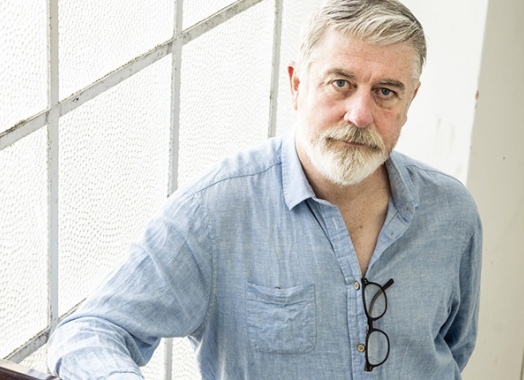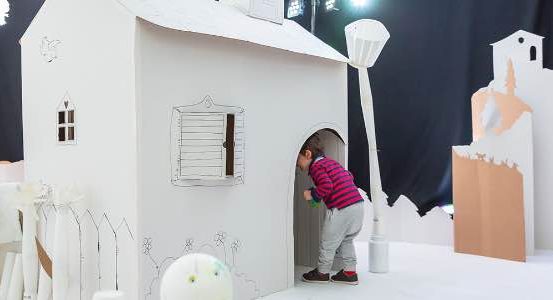
Joanne Reid | Inside the Artist's Studio
Discussing Arts Practice with Joanne Reid, recipient of the Fingal County Council and Draíocht Artist Studio Residency Award 2024

You began your four-month residency in Draíocht’s Visual Artists Studio as you were installing work for Thresholds to the Unseen, a group exhibition in Solstice Navan. How did you approach your residency as you were in the midst of exhibiting new work?
It was a busy time for me, installing at Solstice, moving out of a workshop space at Fire Station Artists' Studios and moving into a new studio residency at Draíocht. I really appreciated having a new studio space to move directly into during this period; giving me time to reflect on the work I had just finished for an exhibition and also the time to start thinking about making new work for an exhibition in 2025. This residency was the first phase in developing a new body of work. It provided me with a base for four months to research, develop ideas and experiment with materials and forms. The fact that the studio residency is funded, made it possible for me to work full time in the studio and really make the most of my time here. I don't have a full time studio space, so residency opportunities like these are really important for my practice.

Powder coated steel. 177 x 78 x 45cm.
Thresholds to the Unseen, Solstice Arts Centre, Co. Meath.
Photo: Lee Welch
Your work looks at our built environment; the industrial, the natural and often construction sites, and combines that with chance encounters. How does your artistic process lead to the production of work, such as the concrete “baguette works”?
My work does reference the materials and forms of our built environment. I often use construction materials such as concrete, plaster, timber, plywood and steel in the fabrication of my work. Many ideas also develop from encounters with objects or detritus I come across while walking in a city. I often photograph items such as foodstuffs, bottles and paper cups, either discarded on pavements or left on various surfaces throughout the city. I have worked with moulding and casting fruits such as lemons as part of my work in the studio. Recently I have been casting vegetable leaves as motifs on plaster and concrete tiles. I am interested in our desire to reproduce the natural world around us and the history of ornament in Architecture.
I usually use my phone to document something I come across that captures my attention. I have a large image bank that I reference for developing work. Sometimes I will also make quick sketches on paper, but mostly its photographs and later on developing drawings on an iPad or laptop, before fabrication. I am particularly drawn to construction sites as a source for my work: the materials, tools and processes on the site, and also the stages of development on a site over time. It reminds me of the process in the studio or workshop, as the work moves from an idea to a finished object. The “baguette works” were made in response to photographing a half baguette, discarded on a pavement, in front of a building site in Dublin City. I used construction materials to create the works. Untitled (baguette with double yellow lines), 2021 consists of a cast concrete baguette resting on top of a cast concrete block. There was also an element of humour in the baguette works. Around the baguette and beam are painted double yellow lines, like road markings. The lines appear to tie both objects together, but also suggest no resting here.

Concrete, paint, plywood, timber. 16.5 x 11 x 67cm
Home Bodies, Glandwr, Chapelizod, Dublin. Photo: Louis Haugh
You’ve spent your time with us researching, exploring and expanding your knowledge and methods of sculpture-making. Being a mould maker and a novice welder, how do you explore making in your practice?
The main focus of this residency was to take the time to read, research, think and develop new ideas for the fabrication of new work for exhibition in 2025. This project is a little different to the way I usually work, in that it is focused on a particular area of Dublin City, exploring the history of the area around The Complex arts centre in Dublin 7. So along with working in the studio, I have spent time walking and photographing the area, looking at specific buildings such as the Dublin City Fruit and Vegetable Wholesale Markets and St. Mary’s Abbey - Chapter House; the ruins of one of the largest monasteries in medieval Ireland. I am also currently reading about Cistercian architecture and medieval tiles. I am also interested in the current redevelopment of sites around the area.
During this residency, I have mainly spent time in the studio, reading, drawing, making new silicone moulds, and experimenting with some new materials for casting objects. Just having time to experiment with materials is really important in developing skills and confidence in working with them. With the process of mould making for example, there can be a certain amount of pre-planning involved in how you approach taking a good mould of an object, especially if it is a multi-part mould. But I also like to just experiment with various techniques and combine different materials to see where it leads.
Some of my studio work is not so planned and often comes about through just experimenting with materials and processes, which can generate new ideas for the work. I think this is particularly true for me when working in steel fabrication. I might have a drawing and plan for a structure, but often the process of cutting, shaping and welding the metal itself, takes the work somewhere else. I find the process of metal working similar to drawing in a way. I did an introductory course in metal fabrication at Fire Station Artists' Studios a few years ago and have experimented with making small structures and using the equipment in the workshop when I have an opportunity to do so. I was very lucky to have funding this year that enabled me to spend a lot of time in metal work, which really improved my welding skills and allowed me to fabricate the work myself for the exhibition at Solstice. I was also able to work more confidently on a larger scale. I'm looking forward to developing my skills further this year and making some new steel works for exhibition.

Photo: Emma Áine O'Leary
Being a local artist how was your experience of having a studio in your local Arts Centre?
It was really beneficial to have a studio space not far from where I live. Firstly, in very practical terms, the travel time and costs were low and it was easier to transport materials from suppliers or from storage to the studio etc. Working in sculpture, I am always having to think about the transport and storage of materials and finished works. I keep everything I make, but unfortunately I may have to think about recycling some older works soon, just to make space for storing newer work. It was also really great to be working in an arts centre and area that I am familiar with and surrounded by the really supportive team working in Draíocht. The fact that this studio residency was also funded, with a monthly stipend and a materials budget, made it possible for me to work full time in the studio for the four months. It is also a large studio space which is great for working in sculpture and having the floor space to plan new work.
The support I received from Fingal Arts Office and Draíocht throughout 2024 was really important to me; allowing me to work full time as an artist and having the time to research, develop my skills and fabricate new works for exhibition. I have really enjoyed the four months I spent here at Draíocht.
In conversation with Emma Áine O'Leary.

Joanne Reid
Visual Artist In Residence Sept-Dec 2024
Joanne Reid is a visual artist working primarily in sculpture. Her work often begins as a direct response to chance encounters with the materials, objects and spaces that form our built environment.
Discover More View all


Artist Support | Tobi Bello - Ethical Framework Development
Ethical Framework Development

Nicole Manning - Instagram Takeover
August 2025

Artist Studio Residency Announced: James McLoughlin
Visual Artist’s Studio Award
September-December 2025
